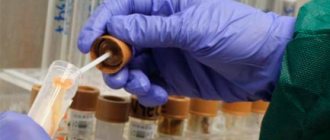Staphylococcus is one of the most common microorganisms. There are many types of staphylococcus, most of which are harmless to humans and constantly live on the skin. However, infection with Staphylococcus aureus or epidermal species of Staphylococcus in combination with a decrease in the patient’s immunity can cause him to develop a number of serious diseases.
In our private clinic in Ryazan, you can take a urine test for staphylococcus, as well as nasal and throat swabs and other biomaterials to identify pathogenic species of this pathogenic microorganism. We use a microbiological method for processing analysis, which not only ensures high accuracy of its results, but also allows us to obtain results in the shortest possible time.
In what cases is culture for Staphylococcus aureus usually prescribed?
Staphylococcus aureus is ubiquitous and is transmitted from person to person through contact, air, water and food. Capable of causing acute and chronic purulent processes in various organs. It can often colonize the mucous membranes of the ENT organs, gastrointestinal tract, and genitourinary system, causing a state of asymptomatic bacterial carriage. Once in the human body, it produces toxins that inhibit the functioning of the immune, nervous systems and gastrointestinal tract. It can become a source of sepsis when immunity is reduced, causing generalized infections with secondary foci of inflammation in the internal organs and the musculoskeletal system.
Staphylococcus aureus can cause food toxic infections when consuming foods contaminated with it and its toxin: uncooked confectionery (containing eggs and dairy products), salads and ice cream.
Children can become infected from adult staphylococcus carriers. In infants, staphylococcus may be isolated from stool cultures.
For epidemiological purposes, the analysis is carried out during annual preventive examinations and during preliminary examinations for employment in the public service sectors: medicine, education, nutrition and trade. In this case, seeding is performed from 2 loci: the nose and pharynx.
How does the infection enter the body?
In terms of infection with pathogenic types of staphylococcus, both diagnosed patients who have already begun treatment and asymptomatic carriers of the infection are equally dangerous. According to WHO statistics, every third such carrier does not even suspect that something is wrong in his body. This is another argument in favor of getting tested for staphylococcus, even in cases where there are no obvious symptoms of infection.
The most common routes of infection with staphylococcus are airborne dust and airborne droplets. In addition, it is possible for pathogenic microorganisms to penetrate through violations of the integrity of the skin and mucous membranes, often not even visible to the naked eye.
The following categories of patients are most often infected with staphylococcus:
- persons with weakened immune defenses of the body;
- patients suffering from various chronic indolent diseases;
- those who live in environmentally disadvantaged regions;
- men and women who are far from leading a healthy lifestyle are smokers, drinkers, fast food fans, who spend little time in the fresh air and neglect physical activity.
How to prepare
Before the analysis, it is necessary, in agreement with the doctor and depending on the type of biomaterial, to stop taking antibacterial drugs, diuretics, laxatives, rectal suppositories and ointments. A urogenital smear is taken from women outside of menstruation.
Staphylococci are quite aggressive bacteria that are highly viable. They can mutate and survive when exposed to drugs. And only timely analysis in a reliable clinic and complex therapy will help get rid of this infection.
Trust your health to professionals! ON CLINIC
Why is infection dangerous?
There are up to thirty species of staphylococcal bacteria, some of which live in the body without harming it.
The most dangerous are Staphylococcus aureus, saprophytic and epidermal staphylococci. The first affects absolutely any tissue and organs in people of any age. The microorganism can cause pneumonia, food poisoning, blood poisoning, meningitis and other dangerous diseases. If the test for Staphylococcus aureus is positive, the patient is immediately prescribed a course of antibiotics, but, unfortunately, this infection is difficult to treat; it is resistant to high temperatures, alcohol, and antibiotics.
Staphylococcus: what to expect and what to do?
Staphylococci are widespread in nature.
They are everywhere.
In water, soil, on the skin and mucous membranes of people and animals. But pathogenic, i.e. Staphylococcus aureus (Staphylococcus aureus) and, to a lesser extent, staphylococcus epidermidis (Staphylococcus epidermidis) may be potentially dangerous. These microbes are classified as opportunistic microorganisms, i.e. they can cause disease only under certain conditions, and generally live quietly on human mucous membranes and skin without causing harm.
In humans, Staphylococcus aureus lives in the intestines, vestibule of the nose, perineum, armpits, and navel. They are found in the vestibule of the nose in 40-50% of healthy adults, in the intestines in 60-70% of healthy people.
Staphylococcus epidermidis is considered non-pathogenic, but in patients with immunodeficiency, prosthetic heart valves, and vascular catheters, they can cause nosocomial infections.
The pathogen can be transmitted from a patient or carrier by airborne droplets, contact, and fecal-oral routes.
The list of diseases caused by staphylococci is very long.
These are infections of the skin and subcutaneous tissue (styes, boils, carbuncles, skin abscesses, imetigo, phlegmon).
Staphylococci are involved in a variety of infections of the ENT organs (sinusitis, tonsillitis, adenoiditis, otitis), and also cause bronchitis and pneumonia.
It is dangerous if infection occurs in a hospital, because nosocomial staphylococci are resistant to many antibiotics and treating such an infection becomes very problematic.
Sometimes, especially in young children, staphylococcal intestinal infections and enterocolitis occur. In adults, foodborne toxic infections more often occur, when the disease is caused not by staphylococcus itself, but by its toxins accumulated in a poor-quality product that has been infected with staphylococci.
If a virulent (highly contagious) strain of staphylococcus appears in a maternity hospital or maternity ward, the infection can spread quickly. More often, the infection in newborns is mild, manifesting mainly as pustules around the nail folds, and occasionally deeper tissues are affected.
In newborns, some strains of staph can cause a severe skin infection called scalded skin syndrome (Ritter's disease). Women who feed a sick child may develop staphylococcal purulent mastitis.
Staphylococcus is also involved in such a serious disease as osteomyelitis (inflammation of the bones and bone marrow). Staphylococci most often enter the bone from foci in the skin or nasopharynx, but sometimes the entrance gates of the infection remain undetected.
If staphylococci penetrate the so-called blood-brain barrier, a terrible disease develops - meningoencephalitis.
Also, with severe immunodeficiency, staphylococcal sepsis can develop. In this case, staphylococcus penetrates into the bloodstream from any source of infection on the skin or subcutaneous tissue.
However, the above severe diseases rarely occur, because in most cases the protective barriers are triggered, and the infection is either limited to local forms and easily treated, or does not develop at all. But it can remain as a carrier, which does not prevent a person from feeling absolutely healthy.
If tests reveal staphylococcus, this does not mean that it needs to be treated.
We should treat only the disease, not tests. And if a person has no complaints, then there is no need to worry in vain.
Workers of certain professions, enterprises and organizations (food industry, maternity hospitals, surgical departments, etc.) are subject to periodic examination and testing for staphylococci. And so, if pathogens are identified, they undergo preventive sanitation of possible foci of infection so that their carriage of staphylococcus does not become a risk factor for others.
Be healthy!
about the author
- Dobrelya Ekaterina Alexandrovna
- Pediatrician, infectious disease specialist of the highest category
- All publications by the author
Antibiotic resistance of staphylococci
The more we attack, for example, pathogens of purulent-septic infections with antibiotics, the more often antibiotic-resistant microorganisms appear.
Under the influence of antibiotics, the inhibitory effect on staphylococci of other microbes - common inhabitants of our body - is disrupted. Moreover, sometimes antibiotics simply stimulate the development of staphylococci and streptococci. Therefore, without medical prescription, the independent use of antibiotics (and other antibacterial agents) in the event of purulent skin lesions should be excluded.
Any treatment for staphylococcal skin pathologies should be prescribed by a dermatologist! Diseases of other organs are treated by appropriate specialists - gynecologists, urologists, therapists.
How to test for staphylococcus at ON CLINIC Ryazan
We detect staphylococcus in nasal and throat swabs, urine and breast milk tests, sputum and eye scrapings, ear canal discharge, urethral and rectal swabs, and stool tests. The attending physician will tell you exactly what material needs to be submitted for the test and how to prepare for the test.
Our private clinic in Ryazan uses the most effective modern diagnostic methods. A multi-stage level of quality control at all stages of the study ensures the accuracy of its results, which in most cases are ready the very next day after the application. As for the prices for this and other laboratory tests in the ON CLINIC Ryazan laboratory, they are at the city average. In addition, our medical center constantly offers various special offers and discounts.
In preparation for the test, stop taking medications for at least a few days. If you cannot stop taking it, discuss this with your doctor. In women, a smear from the vagina and urethra is not taken in the first days of the menstrual cycle.
You can find out how much a staphylococcus test costs at ON CLINIC Ryazan, as well as make an appointment with specialists at our medical center by calling our administrators by phone. We work every day, including weekends and holidays!
Staphylococcal diseases in young people and children
Pustular skin diseases are called pyodermatitis, which, depending on the cause of occurrence, are divided into strepto and staphyloderma. Their mixed form is often observed - streptostaphyloderma.
Streptoderma most often affects children and young men and is usually localized around natural openings - the nose, mouth, ears, that is, in areas subject to irritation by the discharge of these cavities (saliva, mucus). These lesions are very contagious and quickly spread to healthy areas of the skin. Streptoderma is transmitted through toys, diapers, clothes, and underwear.
A fairly common streptococcal skin lesion in newborns is impetigo (from the Latin “impetus” - sudden, attacking). With this disease, flat cavities with a flabby folded covering are formed, filled with serous-purulent contents - phlyctenas.
Merging, they form continuous foci with tortuous inflammatory outlines. Exposed parts of the body are predominantly affected, especially the skin of the face. Nearby lymph nodes often swell, and as the infection spreads, phenomena of general intoxication are observed.
Another form of purulent lesions is neonatal pemphigus. This type of pyoderma is characterized by the formation of large blisters that reach the pigeon egg and are filled with purulent contents. When they rupture, a bare bright red surface (erosion) is formed, which is easily subject to additional infection, resulting in a sharp deterioration in the child’s condition.
Streptococcal pemphigus is extremely contagious, contagious and, in the absence of proper preventive measures, can cause massive outbreaks of pyoderma in maternity hospitals and children's hospitals.
When a child moves home from the maternity hospital, a vesiculopustular form of pyoderma often occurs in places that are most often irritated by sweat (on the back of the head, neck, forehead, groin). Small bubbles with transparent contents (vesicles) the size of a pinhead appear. Then the contents of the vesicles become purulent (pustule) and are surrounded by a halo of hyperemia.
After two to three days, the pustules burst or undergo reverse development and superficial crusts form in their place. Despite the relative ease of this infection, its complications can be very insidious. They are expressed in widespread and severe phlegmon, occurring with significant swelling and subsequent necrosis (melting) of the subcutaneous tissue.
In infants with low nutrition, in improperly bottle-fed children, as well as in older children with weak protective reactions (due to tuberculosis or other types of intoxication), streptococcal infection is not limited to superficial skin lesions, but invades deeper tissues, forming deep ulcers - ecthyma .
They occur on the most frequently injured parts of the body (lower back, lower legs) and are characterized by a sluggish, long-lasting course. After they are healed, scars remain.
Speaking about streptococcal pyoderma in children, we cannot ignore erysipelas, which especially often affects the face (hence the name “erysipelas”). The skin of the face becomes red and swollen. The disease is accompanied by an increase in temperature and sometimes a severe general condition requiring emergency treatment measures.
The so-called “zaeda” is also known - streptococcal phlyctena (a type of impetigo) in the corners of the mouth, which opens and forms a long-term non-healing wound, constantly renewed in connection with facial movements of the facial muscles and food intake. With insufficient sanitary control, seizures can cause real outbreaks in children's groups.
Pemphigus of newborns can also be caused by staphylococci. In the most severe form of this disease, serous fluid accumulates in large areas under the stratum corneum of the skin and detachment of the skin occurs to such an extent that the child gives the impression of being “scalded.”
With staphyloderma, hair follicles are often affected, for example on the head, which leads to a small pustular rash, which disappears without a trace after treatment.
Staphylococci cause not only local, limited skin lesions, but also sore throat, severe pneumonia, inflammatory foci in various organs and tissues (liver, spleen, kidneys), resulting from the spread of microbes through the blood and lymphatic tracts. A generalized staphyloccal infection - sepsis - poses a mortal threat.
Staphylococci can cause real epidemic outbreaks in maternity hospitals and children's hospitals. Due to them, the vast majority of skin and septic lesions in newborns and purulent diseases in mothers occur. Postpartum sepsis, mastitis, pneumonia, meningitis, inflammation of the birth canal, conjunctivitis are a real disaster. Of course, they are especially dangerous for women in labor and newborns.
Types of analyzes
The decision on which study to refer the patient to is made by the attending physician, based on the symptoms and general picture of the disease. The most common blood test is for staphylococcus, but biomaterial is also taken from the throat, nose, ears, wounds, even breast milk is tested. A stool test for staphylococcus and a rectal smear are also informative.
The referral can be written by a general practitioner, ENT doctor, mammologist, dermatologist, gastroenterologist, immunologist and other specialists.









